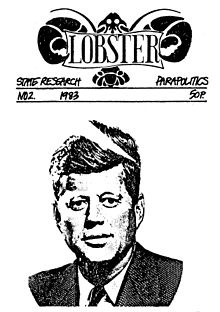 Cover of Lobster's second issue, 1983 | |
| Editor | Robin Ramsay |
|---|---|
| Frequency | Biannual |
| Format | A5 (issues 1–9) A4 (issues 10–57) A4 PDF Online (issue 58+) |
| Circulation | ≈1,200 (1993)[1] 1,300 (2007)[2] |
| Publisher | Lobster |
| Founder | Robin Ramsay Stephen Dorril |
| First issue | 1983 |
| Website | www |
| ISSN | 0964-0436 |
Lobster is a magazine that is interested primarily in the influence of intelligence and security services on politics and world trade, what it calls "deep politics" or "parapolitics". It combines the examination of conspiracy theories and contemporary history.[3][4] Lobster is edited and published in the United Kingdom and has appeared twice a year for 41 years, at first in 16-page A5 format, then as an A4 magazine. Operating on a shoestring, its contributors include academics and others. Since 2009 it is distributed as a free downloadable PDF document.[5]
According to the Hull Daily Mail, Lobster 'investigates government conspiracies, state espionage and the secret service.'[6] In 1986 the magazine scooped mainstream media by uncovering the secret Clockwork Orange operation, implicated in trying to destabilise the British government. Colin Wallace,[7][8] a former British Army Intelligence Corps officer in Northern Ireland, described how he had been instructed to smear leading UK politicians.[9] Questions were asked in the House of Commons and an extended scandal ensued.[10]
The current curator of the CIA Historical Intelligence Collection, Hayden B. Peake,[11] notes that the editors of Lobster see it as "member of the international brotherhood of parapolitics mags," the other members being Geheim (Cologne, Germany), Intelligence Newsletter (Paris, France),[12] and Covert Action Information Bulletin (US), and is "distinctive in its depth of coverage, its detailed documentation, and the absence of the rhetoric".[13]
In 1989, Lobster published names of 1,500 citizens said to be working in intelligence. The magazine was denounced in the House of Commons. The editors replied that all published details could be found in local libraries.[14] The magazine has also carried detailed analysis of fringe and pseudoscientific subjects such as UFOs and remote viewing.[15]
- ^ "Captain Moonlight's Notebook: As pink as two Lobsters", The Independent (London), 14 March 1993, Sunday
- ^ "Sexed-up files, lies and surveillance tapes ... One man's search to uncover what lies beneath", Hull Daily Mail, 13 July 2007 Friday, page 10
- ^ Kenn Thomas, Cyberculture Counterconspiracy, publisher Book Tree, 1999, ISBN 1585091251, 9781585091256, 180 pages, page 71
- ^ Lobster Issue No.1, September 1983, ISSN 0964-0436, which states that it is "a journal/newsletter about intelligence, parapolitics, state structures and so forth"
- ^ Cite error: The named reference
websitewas invoked but never defined (see the help page). - ^ "Sexed-up files, lies and surveillance tapes.... One man's search to uncover what lies beneath", Hull Daily Mail, Friday 13 July 2007, page 10
- ^ Steve Beard, Aftershocks: The End of Style Culture, Publisher Wallflower Press, 2002, ISBN 1903364248, 9781903364246, 180 pages, page 66
- ^ Robin Ramsay, "Kitson, Kincora and counter-insurgency in Northern Ireland", Lobster, Issue 10, January 1986, ISSN 0964-0436.
- ^ Francesca Klug, The Three Pillars of Liberty: Political Rights and Freedoms in the United Kingdom, Publisher Routledge, 1996, ISBN 0415096413, 9780415096416, 400 pages, page 164
- ^ For example, by Kevin McNamara M.P., HC Deb 27 November 1986 vol 106 c309W, retrieved 14 August 2012
- ^ "Contributors", Studies in Intelligence, Center for the Study of Intelligence, Vol. 50, No. 4, 2006, published by the CIA, retrieved 5 January 2012
- ^ Intelligence Newsletter is now published on the Internet as Intelligence Online by Indigo Publications. "About Us", retrieved 5 January 2012
- ^ Hayden B. Peake, The Reader's Guide to Intelligence Periodicals, 1992, published: NIBC Press, pages 86-89
- ^ Richard Norton-Taylor, "Magazine prints security names", The Guardian (London), 29 May 1989
- ^ Thom Burnett, Conspiracy Encyclopedia. New York: Chamberlain Bros. ISBN 1596091568, 978-1843403814. p. 91.